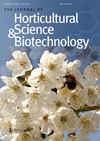柑桔的花粉来源、果座和果皮
IF 2.1
4区 农林科学
Q2 HORTICULTURE
Journal of Horticultural Science & Biotechnology
Pub Date : 1999-01-01
DOI:10.1080/14620316.1999.11511077
引用次数: 52
摘要
摘要研究了不同花粉源对柑桔(Imperial, Ellenor, Murcott)坐果和果实品质的影响。每个品种6棵树分别进行3个异花源、自花授粉、套袋和套袋阉割6种授粉处理。测定了各处理的花粉管生长、坐果率、果重、籽实、糖和酸含量。在所有品种中都发现了显著的xenia效应,包括对糖含量的影响。“帝王”的自交不亲和,因为自交花粉管在花柱上部被抑制。这导致自花授粉果实的坐果量较低(P<0.01),果实重量极低(33-55 g,与92-103 g相比,P<0.01),果实含籽少或不含籽。此外,与自花授粉和不授粉处理相比,‘Ellenor’和‘Murcott’花粉显著提高了果实含糖量0.9 ~ 1.6% (P<0.05)。普遍的……本文章由计算机程序翻译,如有差异,请以英文原文为准。
Pollen source, fruit set and xenia in mandarins
SummaryThe effects of pollen source on fruit set and fruit quality characteristics (xenia effects) were examined in three commercial cultivars of mandarin, Imperial, Ellenor, and Murcott. Six trees of each cultivar received six pollination treatments: three cross-pollen sources, self-pollination, bagging and bagging with emasculation. Pollen tube growth, percentage fruit set, fruit weight, seediness, sugar and acid content were assessed in all treatments. Significant xenia effects, including effects on sugar content, were found in all cultivars. `Imperial' was found to be self-incompatible as self-pollen tubes were inhibited in the upper style. This resulted in a lower fruit set in self-pollinated fruits (P<0.01), a very low fruit weight (33–55 g, compared with 92–103 g, P<0.01), and fruits containing few or no seeds. In addition, `Ellenor' and `Murcott' pollen significantly increased sugar content of fruit by between 0.9–1.6% compared with self-pollinated and unpollinated treatments (P<0.05). Widespread ...
求助全文
通过发布文献求助,成功后即可免费获取论文全文。
去求助
来源期刊
CiteScore
3.90
自引率
5.30%
发文量
67
审稿时长
3 months
期刊介绍:
The Journal of Horticultural Science and Biotechnology is an international, peer-reviewed journal, which publishes original research contributions into the production, improvement and utilisation of horticultural crops. It aims to provide scientific knowledge of interest to those engaged in scientific research and the practice of horticulture. The scope of the journal includes studies on fruit and other perennial crops, vegetables and ornamentals grown in temperate or tropical regions and their use in commercial, amenity or urban horticulture. Papers, including reviews, that give new insights into plant and crop growth, yield, quality and response to the environment, are welcome, including those arising from technological innovation and developments in crop genome sequencing and other biotechnological advances.

 求助内容:
求助内容: 应助结果提醒方式:
应助结果提醒方式:


